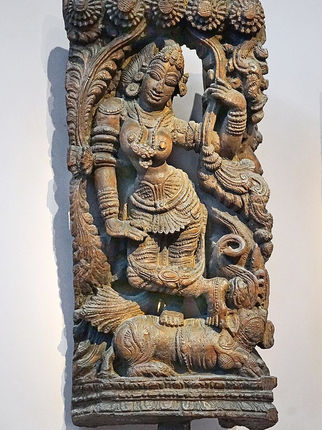
River Goddess
Rivers are considered holy in India and many temples and cities are built along riverbanks. Some rivers are personified as deities since the Indus Valley civilization because of their significant role in supporting civilization. Most of the rivers are represented as female since the flowing water signifies energy and a carrier for creation. However, the Brahmaputra River is a notable example of male personification. The seven most important rivers in Hinduism are called Saptanadi and they are Ganga, Yamuna, Sindu, Narmada, Godavari, Krishna, and the Kaveri. In early Vedic literature, the Sarasvati river was the most significant but as the focus shifted eastwards into the Gangetic plain in the later period, the river Ganga became the most important and sacred river in Hindu tradition.
Ganga
The River initiates in Uttarakhand's western Himalayas and travels across North India's Gangetic Plain into the Bay of Bengal. Many sacred sites associated with various Hindu traditions are situated along her riverbanks. The river water itself is used in various Hindu rituals across India. Hindus also scatter the ashes of the dead into the Ganga wishing for a safe journey of the soul.
Ganga is depicted with two or four arms carrying a kalasha and a lotus, and two hands in the Abhaya and Varada mudras. Her mount is a Makara, a sea creature from Hindu mythology. In several scriptures, the Ganges descends is tamed in Shiva’s locks as persuaded by King Bhagiratha, and hence Shiva, is represented with Ganga shown as a spout of water rising from his locks. In the Mahabharata, she is described to be a consort of Shantanu.
The Bhagirathi is a tributary river in Uttarakhand and one of the two headstreams of the Ganges. The Gange is also called Bhagirathi and the name means “caused by Bhagiratha”. As per the legend, King Bhagiratha promised rigorous penance to bring Ganga from the heavens to the earth to free his ancestors from the crush of sage Kapila.
Yamuna
The Yamuna starts from the southwestern Banderpooch peaks in Uttarakhand and is the second-largest tributary river of the Ganga and the longest tributary in India. In Hindu mythology, the Yamuna, also called Yami, is considered a goddess and she is the daughter of Surya and his spouse Saranyu and the sister of Yama. She is also the consort of Krishna and one of Ashtabharya, as Kalindi. She is depicted as a dark complexed woman and her mount is a tortoise. She carries a kalasha and lotus.
Narmada
Narmada River is located in Madhya Pradesh and Gujarat. The river Narmada, also called the Reva, is an embodiment of a Goddess closely associated with Lord Shiva. As per the legend, the river originated from the sweat of Shiva, while performing the tandava. In another mythology, the Narmada and the Son River formed from the tears of Brahma.
Narmada Devi is depicted with four arms, carrying a trident, Shiva lingam and kalasha, and one hand in Abhaya mudra. Naturally shaped Shiva lingams are found in the river, called Banalinga.
Kaveri
Kaveri River flows through Karnataka and Tamil Nadu. The river is considered to be the embodiment of Goddess Kaveri, the daughter of King Kavera. As per the legend, Kaveri transformed into the water during a drought and Sage Agastya put her in his kamandala to carry her. One day as he rested, Ganesha took the form of a crow and overturned the kamadala and the water became a river. In Skanda Purana, Mohini and Lopamudra retrieved Amrita while the during churning of the Ocean of Milk. Following that, Mohini transformed into a cave in the Brahmagiri mountains, while Lopamudra was adopted by Brahma as his daughter. Brahma afterward presented Lopamudra to King Kavera, who was childless, giving her the name "Kaveri". In a later story, Kaveri transforms into a purifying river to cleanse the river Ganges. Goddess Kaveri is depicted with four hands, carrying a rosary, a lotus, and a pot with flowing water. Sometimes she is shown with two arms, carrying a pot and one hand in Abhaya mudra.
Godavari
The Godavari is the second-longest river in India after the Ganga. Its starts in Triambakeshwar, Maharashtra. As per the legend, sage Gautama performed rigorous penance to Lord Tryambakeshwara, a form of Shiva, to divert the Ganga to flow through Nashik which gave rise to the Godavari river. The Godavari is depicted with two or four arms, standing on Makara, similar to the iconography of Ganga. The sacred river has several pilgrimages on its banks.
Saraswati
The Saraswati River is an ancient river mentioned in the Rig Veda and later texts. The river is revered as the most important and sacred river in the Vedic period. She was also associated with music and was praised for her role in fertility, nourishment, and immortality. Over time, she evolved into the goddess of knowledge and wisdom. Unlike the present peaceful depiction of Goddess Saraswati, the river goddess is described as fierce and ruthless.
Shipra
The Shipra, also known as the Kshipra, is a river that rises from Kakri Bardi Hills in Madhya Pradesh. The Puranas describe that the Shipra originated from the heart of Varaha and because of that the river is worshipped as a goddess.
Tapti
Tapti is a river in central India flowing through Maharashtra, Gujarat and Madhya Pradesh, and draining into the Arabian Sea. Tapati is independently mentioned in the Mahabharata as a goddess and also the goddess of the river Tapati. As per the texts, she was the daughter of Surya and Chhaya.
Vipasha
Vipasha is the goddess of Beas River originates in the Himalayas of central Himachal Pradesh and merges with the Sutlej River in Punjab, India. The river Beas has the given name of Veda Vyasa, who is attributed with creating it from its source lake, the Beas Kund, in the Indian epic Mahabharata.








